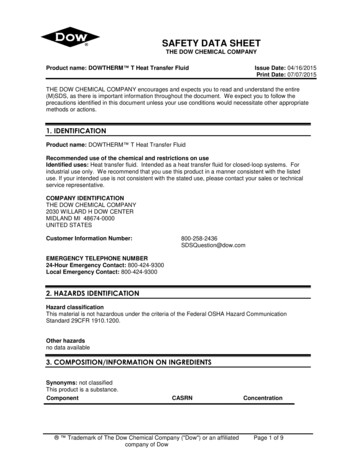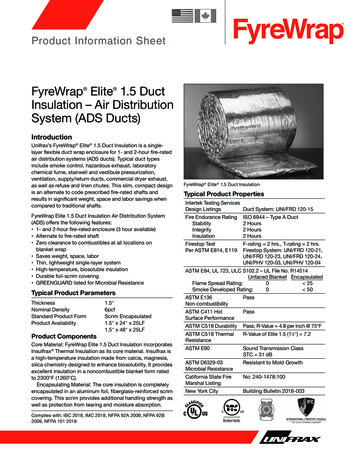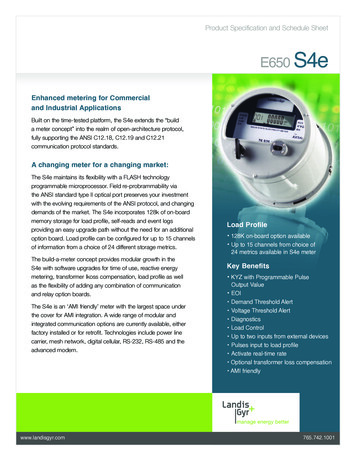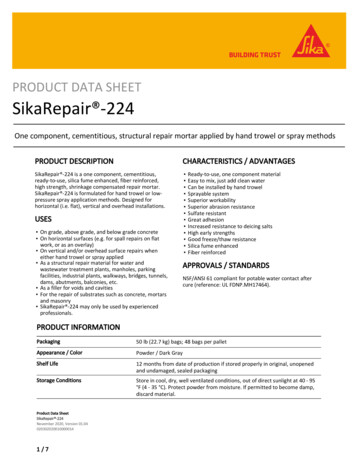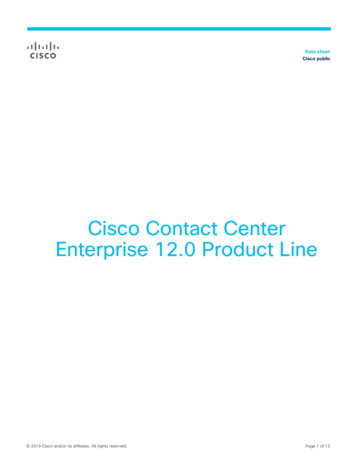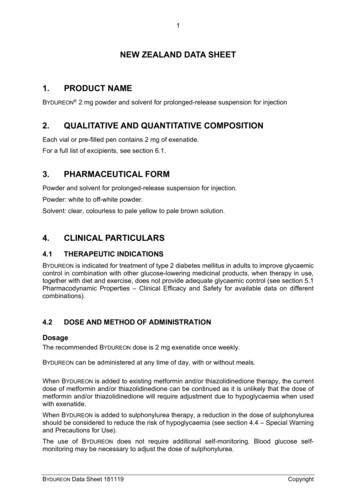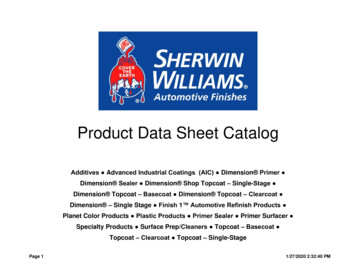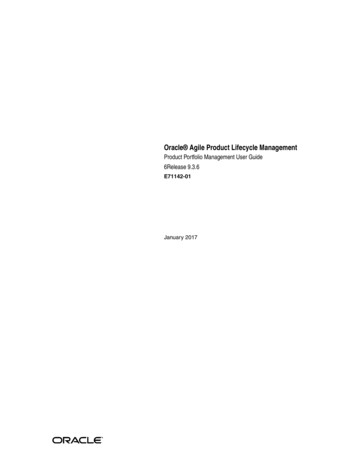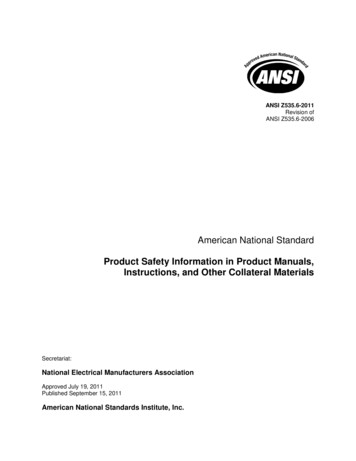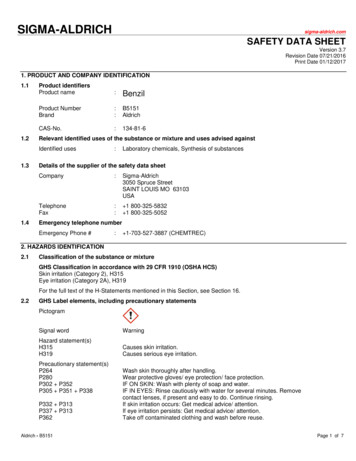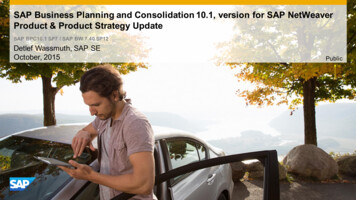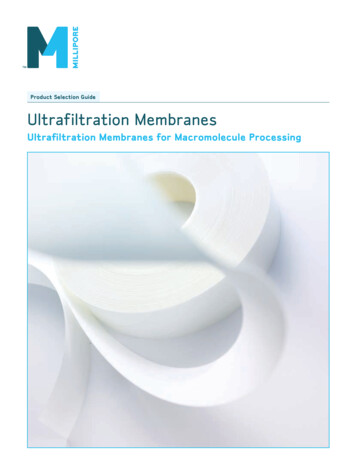
Transcription
Data SheetProductSelection GuideUltrafiltration MembranesUltrafiltration Membranes for Macromolecule Processing
Ultrafiltration Membranes forMacromolecule ProcessingUltrafiltration (UF) is the process of separatingextremely small particles and dissolved molecules fromfluids. The primary basis for separation is molecular size– particles ranging from 1,000 to 1,000,000 molecularweight are retained by ultrafiltration membranes.Biomax PB Membranesultracel PL MembranesBiomax PB membranes are well suited for applicationsrequiring high flux, low to moderate protein binding,and harsh chemical cleaning and/ or sanitization. Madeof polyethersulfone (PES), these void-free membranesare caustic and chlorine resistant, and are modified toreduce non-specific protein binding and fouling. The highflux and high retention of Biomax membranes result infaster processing speeds with higher yields. This allowsshorter processing time and more compact processingsystems.Ultracel PL membranes are ideal for the concentrationand desalination of solutes especially when only smallvolumes or low concentrations are available. Themembrane’s permeability is optimized for improvedperformance with high solute retention and higherflux levels. In addition, the regular non-voided supportlayer is also more resistant to damage due to handling,manufacture or process condition variations.Product Features Available in a broad range of molecular weight cut-Product Features Composite PES membrane provides a stable hydraulicenvironment for excellent mechanical strength andintegrity. Void-free structure results in higher flux, excellentoffs. Polypropylene backing material provides supportwithout impeding flow. Low to moderate protein binding.retention, and higher yields.Millipore’s UF membranes are manufactured in our worldclass facility in Jaffrey, New Hampshire. This state-ofthe-art facility is dedicated to the reliable production ofour high quality UF membranes, deploying gMP practicesand ISO compliant measures. The 44,000 sq ft facilityis a Commissioned Class 100K controlled environment;containing the most innovative manufacturingequipment and processes in the industry.This guide provides an introduction to Millipore’sfamily of Ultrafiltration Membranes and an overview ofthe key criteria and product characteristics to considerwhen selecting an UF membrane for your applicationor medical device. Using this guide will help ensurehigh levels of retention; however optimization throughexperimentation should always be conducted to find asuitable balance between retention and flow rate levels. Low to moderate protein binding – for use withBiomaxPB Membranes protein solutions containing more than 0.1 mg/mL ofprotein. Available in a broad range of molecular weight cut-offsto suit a variety of applications.Ultracel PLC MembranesUltracel PL MembranesUltracel PLC MembranesProduct FeaturesProduct FeaturesFor a complete listing of our membrane products, pleasevisit www.millipore.com/oemproducts.improved integrity. Ultra-low protein binding – for use with proteinsolutions (less than 0.1 mg/mL).ViresolveMembranesVirus contamination poses a threat to the safetyof clinical compounds derived from recombinant orhuman plasma sources. Patented, composite Viresolvemembranes provide reliable and consistent viralclearance. Viresolve membranes are available in varietiessuitable for normal-flow and tangential-flow filtration.Ultracel PLC membranes are the membranes ofchoice for high-recovery purification. These void-freemembranes combine ultra-low protein binding and lowfouling with solvent resistance and superb mechanicalstrength. Casting the regenerated cellulose membraneonto a microporous polyethylene substrate createsa uniform, robust structure, with high integrity andgreater resistance to back pressure. Void-free structure results in excellent retention and Viresolve Membranes Composite structure gives the membrane improvedback pressure resistance. Available in a broad range of molecular weight cut-offsto suit a variety of applications. Low-binding polyvinylidene fluoride structure yieldshigh protein recovery (greater than 90%). Greater than 3 log removal of viruses for quantifiablevirus load reduction. Suitable for normal-flow and tangential-flow filtrationapplications.
Biomax PB MembranesMembrane NameNMWL CuttoffMembrane MaterialBiomax 8Biomax 10Biomax 30Biomax 50Biomax 100Biomax 300Biomax 500Biomax 1000PBSEQ5 kiloDalton8 kiloDalton10 kiloDalton30 kiloDalton50 kiloDalton100 kiloDalton300 kiloDalton500 kiloDalton1000 kiloDalton8 fonePolyethersulfonePolyolefin NonwovenPolyolefin NonwovenPolyolefin NonwovenPolyolefin NonwovenPolyolefin NonwovenPolyolefin NonwovenPolyolefin NonwovenPolyolefin NonwovenPolyolefin NonwovenPolyolefin NonwovenDextran Retention90% at 10 kD90% at 18 kD90% at 15 kD90% at 70 kD90% at 95 kD90% at 160 kDBP 80 psiBP 45 psi to 90 psiBP 30 psi to 55 psi90% at 18 kDThickness280 microns280 microns280 microns280 microns280 microns280 microns280 microns280 microns280 microns280 micronsAir Permeability0 at 30 psi0 at 30 psi0 at 30 psi0 at 30 psi0 at 30 psi0 at 30 psi0 at 30 psi0 at 30 psi1 ml/min at 10 psi0 at 30 psiWater Flux3.5 lmh/psi10 lmh/psi27 lmh/psi37.5 lmh/psi47.5 lmh/psi95 lmp/psi230 lmh/psi390 lmh/psi750 lmh/psi15 lmh/psiMembrane CodePBCCPBFCPBGCPBTKPBQKPBHKPBMKPBVKPBXKPBSEQpH �141–141–14Max Operating Temp80 C80 C80 C80 C80 C80 C80 C80 C80 C80 C30 inches*15 inches**30 inches*30 inches*30 inches*30 inches*15 inches**15 inches**30 inches*15 inches**400 feet400 feet400 feet400 feet400 feet400 feet400 feet400 feet400 feet400 feetSupport MaterialHigh FluxBiomax 5Max Support WidthStandard LengthMaximum Retention/Lowest BindingUltracel PLC MembranesMembrane NameUltracel 5 kDUltracel 8 kDUltracel 10 kDUltracel 20 kDUltracel 30 kDUltracel 100 kDUltracel 300 kDUltracel 1000 kD5 kiloDalton8 kiloDalton10 kiloDalton20 kiloDalton30 kiloDalton100 kiloDalton300 kiloDalton1000 kiloDaltonRegenerated CelluloseRegenerated CelluloseRegenerated CelluloseRegenerated CelluloseRegenerated CelluloseRegenerated CelluloseRegenerated CelluloseRegenerated CelluloseUHMW PolyethyleneUHMW PolyethyleneUHMW PolyethyleneUHMW PolyethyleneUHMW PolyethyleneUHMW PolyethyleneUHMW PolyethyleneUHMW PolyethyleneDextran Retention90% at 5 kD90% at 8 kD90% at 5 kD90% at 10 kD90% at 30 kD90% at 100 kD90% at 300 kD90% at 840 kDAverage ThicknessNMWL CuttoffMembrane MaterialSupport Material130 microns200 microns130 microns130 microns130 microns130 microns130 microns130 micronsAir Permeability0 at 70 psi0 at 70 psi0 at 70 psi0 at 70 psi0 at 30 psi0 at 30 psi 2.5 cc/min at 30 psi 2.5 cc/min at 30 psiAve Water Flux1 lmh/psi3.5 lmh/psi4.2 lmh/psi9 lmh/psi21.5 lmh/psi94.5 lmh/psi272 lmh/psi300 lmh/psiMembrane 32–132–132–132 –132 –132 –132 –13pH rangeMax Operating Temp80 C80 C80 C80 C80 C80 C80 C80 CMax Width13 inches13 inches13 inches13 inches13 inches13 inches13 inches13 inchesStandard Length350 feet350 feet350 feet350 feet350 feet350 feet350 feet350 feetViresolve MembranesMembrane CodeNMWL CuttoffMembrane MaterialSupport MaterialPLACPLBCPLCCPLGCPLTKPLHK1 kiloDalton3 kiloDalton5 kiloDalton10 kiloDalton30 kiloDalton100 kiloDaltonRegenerated CelluloseRegenerated CelluloseRegenerated CelluloseRegenerated CelluloseRegenerated CelluloseRegenerated CellulosePolypropylene NonwovenPolypropylene NonwovenPolypropylene NonwovenPolypropylene NonwovenPolypropylene NonwovenPolypropylene NonwovenDextran Retention90% at 1 kD90% at 3 kD90% at 5 kD90% at 10 kD90% at 30 kD90% at 100kDThickness230 microns230 microns230 microns230 microns230 microns230 microns 5 mL/min at 30 psi 5 mL/min at 30 psi 5 mL/min at 30 psi 5 mL/min at 30 psi 5 mL/min at 30 psi 5mL/min at 30 psiAir PermeabilityWater Flux0.5 lmh/psi1.0 lmh/psi1.5 lmh/psi7.5 lmh/psi25 lmh/psi30 lmh / PSIMembrane CodePLACPLBCPLCCPLGCPLTKPLHKpH Range2 – 102 – 102 – 102 – 102 – 102 – 10Max OperatingTemp80 C80 C80 C80 C80 C80 CMax Width27 inches27 inches27 inches27 inches27 inches27 inchesStandard Length200 feet200 feet200 feet200 feet200 feet200 feetCoated UF Width: * 27.5 inches, ** 13.25 inchesVirus ClearanceMaximum Retention/Lowest BindingUltracel PL MembranesMembrane NameViresolve 180Viresolve 180 (NormalFlow Filtration)RetrovirusMembraneNMWL Cuttoff180 kiloDalton180 kiloDaltonNAMembrane MaterialPVDFPVDFPES (asymmetric)Support MaterialNoneNoneNoneThicknessWater PermeabilityMembrane CodeEndotoxinsExtractables150 µm150 µ m140 µm63 lmh/psi63 lmh/psi110 lmh/psiPPVGPPVGNFRVRM 0.5 Eu/mL 0.5 Eu/mL 0.5 Eu/mL 0.3 % 0.3 % 10 µg C/cm2LRV 1.5LRV 1.5LRV 64–84–84–837 C37 C80 CMax Width12 inches12 inches11 inchesStandard Length500 feet500 feet1,000 feetVirus RetentionpH rangeMax Operating Temp
Selecting the nominalmolecular weight limit (NMWL)Rating for Concentrating,Desalting, and Buffer Exchangeof Macromoleculesis globular or is a protein, stop at the light blue line;if your macromolecule is linear or is a polysaccharide,stop at the dark blue line. This point correspondson the y-axis to the Stokes radius (in nm) of thatmacromolecule in aqueous solutions.3 To determine the radius move horizontally to the leftto determine the recommended Millipore ultrafiltrationmembrane for your application.This rating reflects the molecular weight of solutesretained by the membrane. Reference the chart to selectan appropriate Millipore ultrafiltration membrane basedon NMWL cutoff. The chart is accurate for applicationsrequiring the membrane to pass only water, salts, andother low molecular weight molecules.1 Determine the radius of the smallest virus or colloidparticles in nanometers.2 Move vertically from the molecular weight until youintersect one the diagonal lines. If your macromoleculeStokes Radius (nm)403 From the radius move horizontally to the right todetermine the recommended Millipore ultrafiltrationmembrane for your application.Linear Molecules and PolysaccharidesGlobular Molecules and 09876530PLTK10PLGC435PLCC23PLBC1PLAClow protein binding fordilute proteins11Microfiltration.01 µm.1 µm0.2 kDa200 kDa20,000 kDaClarification1 µm10 µm101001,000Molecular Weight (kDaltons)10,000Carbon BlackOligonucleotidesSaltsRed BloodCellB. diminutaProteinsAmino AcidsNucleotidesAntibioticsStokes Radius (nm)50Ultrafiltration0.001 µmSugars2 Locate that radius on the left hand side y-axis ofthe chart.Size of Molecule Retained by UF MembraneRegenerated CelluloseReverse Osmosis100 µmFor Viruses and Colloids:1 Determine the molecular weight (in kiloDaltons) of themacromolecule the membrane should retain. Locate themolecular weight on the x-axis of the chart.7060This table is an overview of common filtrates and particles with the recommended filtration/separationtechnology based on the size and/or type of filtrate or particle.0.0001 µmFor Macromolecules:Select Membrane toRetain SpeciesComparison of Ultrafiltration with Other CommonlyUsed Membrane Separation TechniquesPolioVirusMammalian VirusYeastMycoplasmaE. coliBacteriaSmallestVisible ParticlePollensClouds FogHumanHair
For more informationCall 1-800-MILLIPORE orvisit ficesMillipore, Biomax, Amicon, Viresolve and Ultracel are registered trademarksof Millipore Corporation.M mark and Advancing Life Science Together are trademarks of Millipore Corporation.Lit. No. PF1172EN00 Rev. C Printed in the USA. 04/08 08-106 2008 Millipore Corporation, Billerica, MA 01821 U.S.A.All rights reserved.
coMPariSon oF UltraFiltration witH otHer coMMonly USeD MeMBrane SeParation tecHniQUeS This table is an overview of common filtrates and particles with the recommended filtration/separation technology based on the size and/or type of filtrate or particle. Reverse Osmosis 0.2 kDa Ultrafiltration Microfiltration Clarification 200 kDa 20,000 kDa

